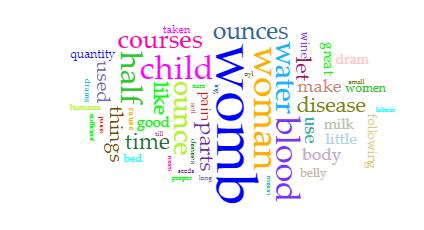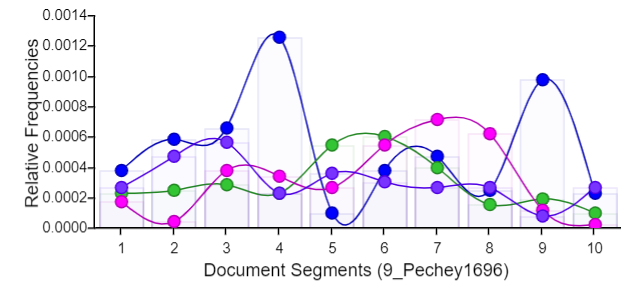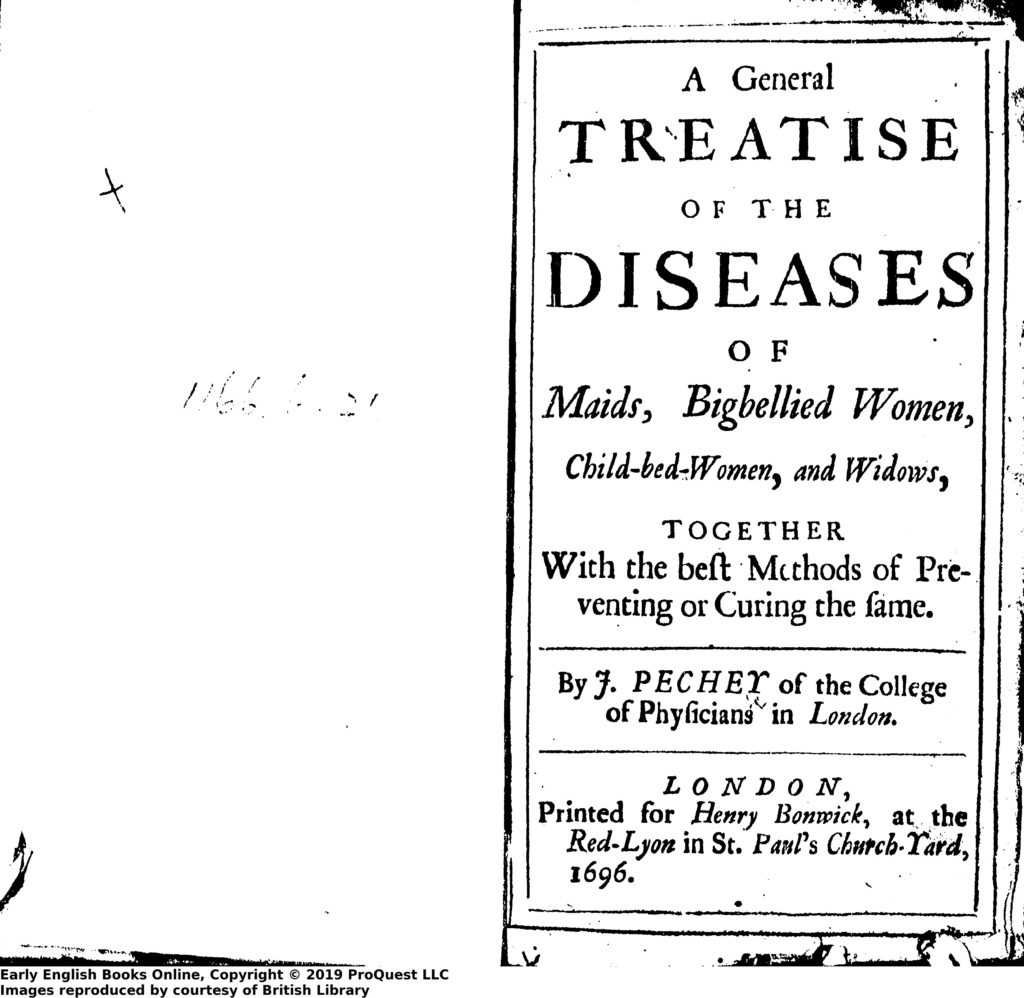A General Treatise
| Title | A general treatise of the diseases of maids, bigbellied women, child-bed-women, and widows together with the best methods of preventing or curing the same |
|---|---|
| Contributor(s) | Pechey, John |
| Year | 1696 |

This is a visualisation taken from Voyant Tools which shows the most common words and concerns of this text and how it pertains to the female body. Words to describe menstruation appear (‘courses’) while evidently some remedies for women’s health are suggested (‘drams’ of wine, ‘ounces’). The womb is important, as are words like ‘blood’, ‘body’ and ‘humours’.
The 1696 text A general treatise of the diseases of maids, bigbellied women, child-bed-women, and widows together with the best methods of preventing or curing the same by John Pechey (1655-1716) appears at the close of the 17th century and thus operates at a liminal junction in historical conceptions of the medicalised female body. This title is interesting, as it contains the word ‘bigbellied’, discussed in our literature review as referring to unmarried mothers.



Voyant Tools describes Trends as “a visualization that represents the frequencies of terms across documents in a corpus or across segments in a document”. This graph gives various insights into how the body is present across each segment of the text. All four key words appears in every segment of the text, with ‘womb’ having the highest peak, twice. ‘Blood’ appears to have the most stable frequencies.
Below is the Table of Contents of this text, taken from the epub made available from the Bodleian Library of Oxford University. This was edited using Sigil to remove HTML and other redundant material. We recognise the Bodleian Library as the owners of this material and we are grateful to be able to use open-source material in our research.
The sheer scale of diseases that practitioners believed women were prone to develop can be understood from this long list of ailments. The womb was believed to be the central locus point for these diseases, an idea inherited from Classical schools of thought. Contemporary language for the body can be seen that would not appear in modern medical texts include ‘Hill of Venus’, ‘Hymen’ and ‘Womb-Cake’. Issues around selecting an appropriate nurse to breastfeed a newborn would also not be found in today’s medicine.
- Abscesses
- Acrocordo
- Acute Diseases of Women in Child-bed
- After-pains
- Allantois
- Amnios
- Back pains
- Barrenness
- Bath-waters
- Belly-bound
- Bloody-Flux
- Breasts Cancerated
- Caesarian Delivery
- Chaps in the Nipples
- Child-bed Purgations
- Child dead
- Choice of a Nurse
- Clefts of the Privities
- Clitoris
- Conception
- Condyloma
- Corion
- Cough
- Courses
- Ficus
- Flooding
- Green-sickness
- Hermophrodites
- Hill of Venus
- Hip-Pains
- Hymen
- Hysteric Diseases
- Infant nourished
- Inflation of the Womb
- Labour hard
- Decoction
- Delirium
- Dropsie of the Womb
- Eggs
- Emulsion
- Epilepsie
- Fallopian Tubes
- Labour contrary to Nature
- Legs swell’d
- Liquid Laudanum
- Loosness
- Lozenges
- Madness
- Melancholy
- Milk
- Miscarriage
- Mole
- Myrtle berry Caruncles
- Navel-string
- Nymphs
- Piles
- Privities
- Reins pain’d
- Scabs of the Privities
- Secundine retain’d
- Sphincter
- Stone of the Womb
- Suckling of a Child
- Superfaetation
- Testicles
- Thymus
- Tumours from Milk
- Ʋlcers corrosive
- Vomiting
- Ʋrachus
- Ʋrine difficult
- Warts
- Water breaking
- Whites
- Womb closed
- Womb
- Womb-Cake
- Woman with Child managed
- Womb bearing down
- Womb falling
- Womb Cancerated
- Womb Worms
- Wrinkles in the Belly
We are somewhat limited in what we can display for this book, as we were only able to consult text files made available by the University of Michigan which does not offer images. Other institutions which have a copy of this text in their collections include the Wellcome Foundation, the University of Manchester and Bodleian Library of Oxford University but they do not offer online access to the general public to the digitized content, aside from the epub as mentioned above. There is a digital text file hosted by ProQuest that we were able to consult using our institutional logins, from which we have taken the cover page as shown above, but it is not possible to embed the full text.



